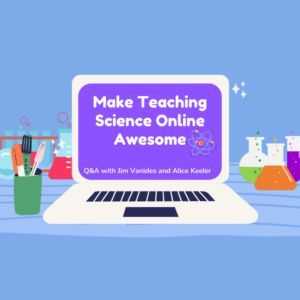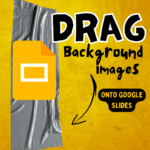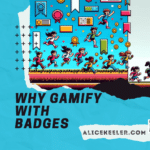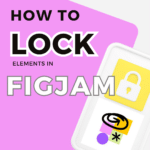
Jim Vanides (@jgvanides) is incredibly engaging. Each time we get together I feel like I could make Instagram quotes of nearly everything he says. We got together for a chat about how teaching online (science) can be amazing. After an hour of a great conversation I just wanted more! I bet you will too! Jim has an online workshop on teaching science. I think the best way to really see how great online can be is to have a great experience. Fill out this Form to find out when Montana State is offering the online workshop again.
Do not start with technology; Start with a verb.
Match the Best Tech After Planning the Objective
A common mistake is that teachers will start with a technology and then lesson plan.
In fact, Jim says, “don’t start with stuff, start with verbs.” He suggests to think about the activity, learning verbs, what teacher and students will be doing and then matching the tech platform that goes best with that lesson. Starting with Technology will not get your students where you are hoping to lead them.
Exploring, doing, modeling, he suggests to start with PHET Interactive Simulations. PHET simulations were successful because students repeated the science investigations at home in their free time. Jim reminds us our goals is to help students understand they can use science to answer their own questions! PHET is a great place to start.
Asynchronous does NOT have to be “A LONE”
Asynchronous Collaborative
When we talk asynchronous, Jim offers that it shouldn’t just be alone or study time. Students can use this time for collaborative learning!
Asynchronous Collaborative is how Jim describes is online science teaching. It’s hands-on, inquiry based, working together having conversations even though not everyone is online at the same moment. It’s not the same as “self-paced, sit in a corner and read a textbook or watch a video by yourself.” For instance, if using Google Classroom and having a discussion about a topic, students could continue sharing their thoughts and research for weeks and months. The time is not the focus, the depth and wonder takes center stage as students explore the concept over time.

Let curiosity drive student learning.
Distributing Information is Not Teaching
Both Alice and Jim encourage educators not to frontload lessons! That means, don’t give all the good stuff away at the beginning of a lesson. Does the lesson you are planning allow students to follow a natural curiosity to lead them? Can they come up with multiple ideas that can be discussed and taken seriously? Can they continue to explore at home because they know how to access the tools they need and know how one variable relates to the outcomes? This kind of learning is the picture of true engagement. It doesn’t only happen inside of the four walls of a classroom or in a Zoom meeting. Alice shared that she doesn’t lesson plan further out than three days so her plans follow what is happening with her class, not what is being dictated by a textbook or limited lesson plan.
Give Yourself Grace
Remember that no only do our students grow in learning, but we do, too. Most of us were shoved into virtual teaching because of the pandemic. Whatever your year looks like, you’re going to realize you have grown and know more than you did a year ago. Next year, you’ll know even more. That’s the real beauty of being a learner for life, we are also always a student! We hope you found this webinar and blog helpful. Stay tuned for more LIVE broadcasts that feature education technology that all teachers can use this coming year!








